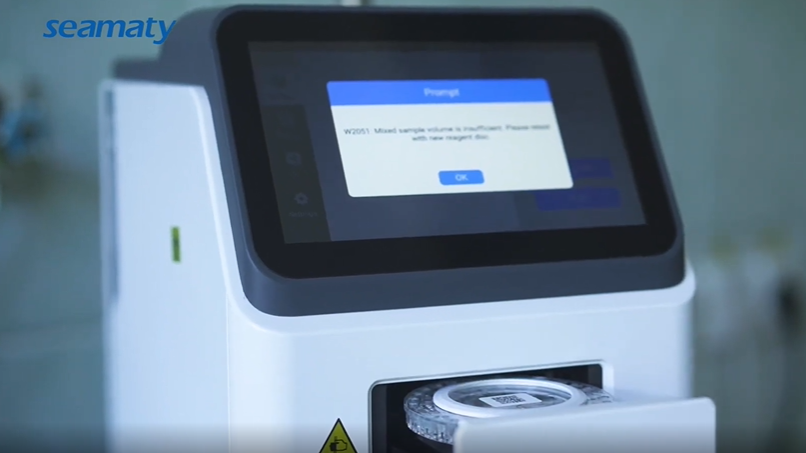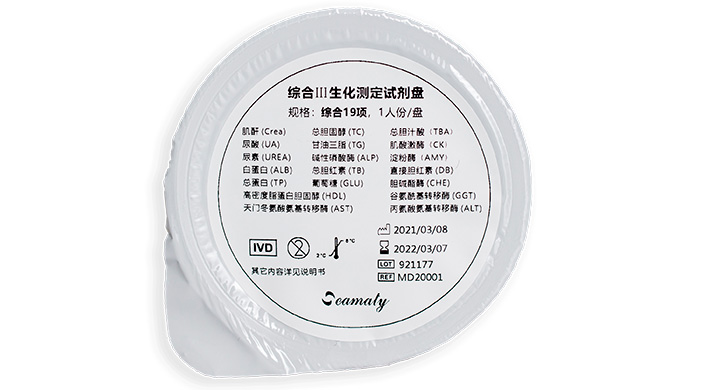release time:2023-05-05 13:40:28
Seamaty's fully automated immunoassay analyzer is a state-of-the-art instrument that allows for efficient and accurate measurement of various analytes in biological samples. To ensure optimal performance and reliable results, it is crucial to maximize the value of this instrument. In this article, we will discuss tips and best practices for maximizing the value of Seamaty's automated immunoassay analyzer.
 II. Tips for maximizing the value of Seamaty's automated immunoassay analyzer
II. Tips for maximizing the value of Seamaty's automated immunoassay analyzer
A. Regular maintenance and calibration
To ensure optimal performance and accurate results, it is important to perform regular maintenance and calibration of the instrument. This includes cleaning the instrument regularly, checking for any signs of wear or damage, and performing routine calibration checks.
B. Proper storage and handling of reagents
The quality of the reagents used in automated immunoassay analyzers is crucial for obtaining accurate and reliable results. Therefore, it is important to store reagents properly, following the manufacturer's instructions. In addition, reagents should be handled carefully to avoid contamination.
C. Optimizing assay parameters
Optimizing assay parameters, such as incubation time and temperature, can significantly improve the accuracy and precision of results. It is important to optimize these parameters according to the manufacturer's instructions and to monitor the results regularly.
D. Appropriate training for operators
Operators should receive appropriate training before using the automated immunoassay analyzer. This includes training on how to operate the instrument, handle reagents, and troubleshoot any issues that may arise.
E. Utilizing quality control measures
To ensure the accuracy and reliability of results, it is important to incorporate quality control measures into the assay. This includes running quality control samples regularly and monitoring the results to ensure that they fall within acceptable limits.
F. Troubleshooting common issues
Even with proper maintenance and calibration, issues may arise with the automated immunoassay analyzer. Therefore, it is important to be familiar with common issues and to have a troubleshooting plan in place to quickly resolve any problems.
In addition to the tips listed above, there are several best practices that can help ensure accurate and reliable results when using Seamaty SMT-680 fully automated immunoassay analyzer.
A. Ensuring Proper Sample Preparation
One of the most critical steps in immunoassay analysis is proper sample preparation. Samples should be handled with care and stored appropriately to prevent degradation or contamination. Additionally, proper labeling and tracking of samples can help ensure accurate results. SMT-680 can obtain accurate results with samples as small as 10 μL of blood each parameter.
B. Accurate Pipetting Techniques
Accurate pipetting is crucial for obtaining reliable and reproducible results in immunoassay analysis. Operators should be trained on proper pipetting techniques and regularly check pipettes for accuracy and precision. SMT-680 uses the same time-proven laboratory chemiluminescence technology, precision at the picogram level.
C. Understanding the Importance of Controls and Standards
The use of controls and standards is essential for ensuring the accuracy and precision of immunoassay results. Controls and standards should be prepared and used according to the manufacturer's instructions, and their results should be monitored regularly.
D. Recording and Analyzing Data Accurately
Proper record-keeping and data analysis are critical for ensuring the validity and reproducibility of immunoassay results. Operators should be trained on how to record data accurately and how to analyze and interpret the results.
E. Following Safety Protocols
Finally, it is crucial to follow safety protocols when using automated immunoassay analyzers. Operators should be trained on proper handling and disposal of hazardous materials, as well as on how to properly use personal protective equipment.
Compared to other immunoassay analyzers, the SMT680 offers the following advantages:
1. Laboratory-grade precision
2. Fast detection
3. Convenient and efficient
4. Multiple applications
5. Micro-sampling
6. Completed Test Menu
As a fully automated immunoassay analyzer with high quality, the SMT680 is simple, reliable, and flexible to help optimize your laboratory's analytical performance.
A. What is the use of automated immunoassay analyzer?
Automated immunoassay analyzers are used to measure the presence and quantity of specific molecules in biological samples. These analyzers are widely used in clinical laboratories for diagnosing and monitoring a variety of medical conditions.
B. How does an immunoassay analyzer work?
Immunoassay analyzers use antibodies to detect and measure specific molecules in biological samples. The sample is added to a well containing the antibody, and any target molecules present will bind to the antibody. The bound molecules are then detected using a variety of methods, including fluorescence, chemiluminescence, and colorimetry.
C. What are the different types of automated immunoassays?
There are several different types of automated immunoassays, including enzyme-linked immunosorbent assays (ELISAs), chemiluminescence immunoassays (CLIAs), and fluorescence immunoassays (FIAs).
D. What is the most common method of automated immunoassay?
Enzyme-linked immunosorbent assays (ELISAs) are one of the most commonly used methods of automated immunoassay. They are highly sensitive and specific, making them useful for a wide range of applications.
E. Is Seamaty SMT-680 a chemiluminescence immunoassay analyzer?
Yes. Chemiluminescence immunoassay is an analytical method that determines the content of a substance based on the intensity of the radiation light produced by a chemical reaction. The chemiluminescence immunoassay analyzer combines a chemiluminescence system with an immune reaction. It edits antibodies or antigens with chemiluminescence-related substances, and after reacting with the antigen or antibody to be measured, it performs quantitative or qualitative detection of the antigen or antibody by separating the chemiluminescence marker in the free state and adding other related substances of the chemiluminescence system to produce chemiluminescence.
In conclusion, maximizing the value of Seamaty's automated immunoassay analyzer requires careful attention to both tips and best practices. Regular maintenance and calibration, proper storage and handling of reagents, optimizing assay parameters, appropriate operator training, and utilizing quality control measures are all important for obtaining accurate and reliable results.
Additionally, following best practices for sample preparation, pipetting, control and standard usage, record-keeping and data analysis, and safety protocols can help ensure the validity and reproducibility of immunoassay results.
Finally, understanding the use and function of automated immunoassay analyzers, how they work, and the different types available can help operators make informed decisions about their use. By following these guidelines, operators can maximize the value of Seamaty's automated immunoassay analyzer and ensure the highest quality results.
▼Click to watch the operation guide video of SMT-680 analyzer▼

2022-08-03
A clinical chemistry analyzer is a machine used in the diagnosis and treatment of disease. It is used to measure various chemicals in the blood, urine, or other body fluids. This information can be used to help identify and diagnose problems. Clinical chemistry analyzers are an important part of modern healthcare. They allow for fast and accurate analysis of patient samples. This helps ensure that patients receive the best possible care.

2021-11-12
With the popularity of the application of dry biochemistry analyzer, it can test more and more items. Here is an example of the Seamaty Automatic Dry Chemistry Analyzer SD1. Let's see what items it can test.

2021-10-19
Point of care testing is a rapid test performed in the presence of the patient and the person being tested. It is not necessarily performed by a specialist examiner.